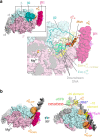Structural insights into the mycobacteria transcription initiation complex from analysis of X-ray crystal structures
- PMID: 28703128
- PMCID: PMC5511352
- DOI: 10.1038/ncomms16072
Structural insights into the mycobacteria transcription initiation complex from analysis of X-ray crystal structures
Abstract
The mycobacteria RNA polymerase (RNAP) is a target for antimicrobials against tuberculosis, motivating structure/function studies. Here we report a 3.2 Å-resolution crystal structure of a Mycobacterium smegmatis (Msm) open promoter complex (RPo), along with structural analysis of the Msm RPo and a previously reported 2.76 Å-resolution crystal structure of an Msm transcription initiation complex with a promoter DNA fragment. We observe the interaction of the Msm RNAP α-subunit C-terminal domain (αCTD) with DNA, and we provide evidence that the αCTD may play a role in Mtb transcription regulation. Our results reveal the structure of an Actinobacteria-unique insert of the RNAP β' subunit. Finally, our analysis reveals the disposition of the N-terminal segment of Msm σA, which may comprise an intrinsically disordered protein domain unique to mycobacteria. The clade-specific features of the mycobacteria RNAP provide clues to the profound instability of mycobacteria RPo compared with E. coli.
Conflict of interest statement
The authors declare no competing financial interests.
Figures






References
-
- Murakami K. S., Masuda S., Campbell E. A., Muzzin O. & Darst S. A. Structural basis of transcription initiation: an RNA polymerase holoenzyme-DNA complex. Science 296, 1285–1290 (2002). - PubMed
Publication types
MeSH terms
Substances
Grants and funding
LinkOut - more resources
Full Text Sources
Other Literature Sources

